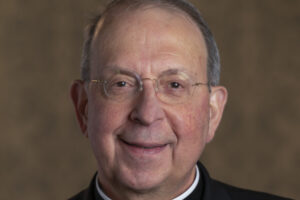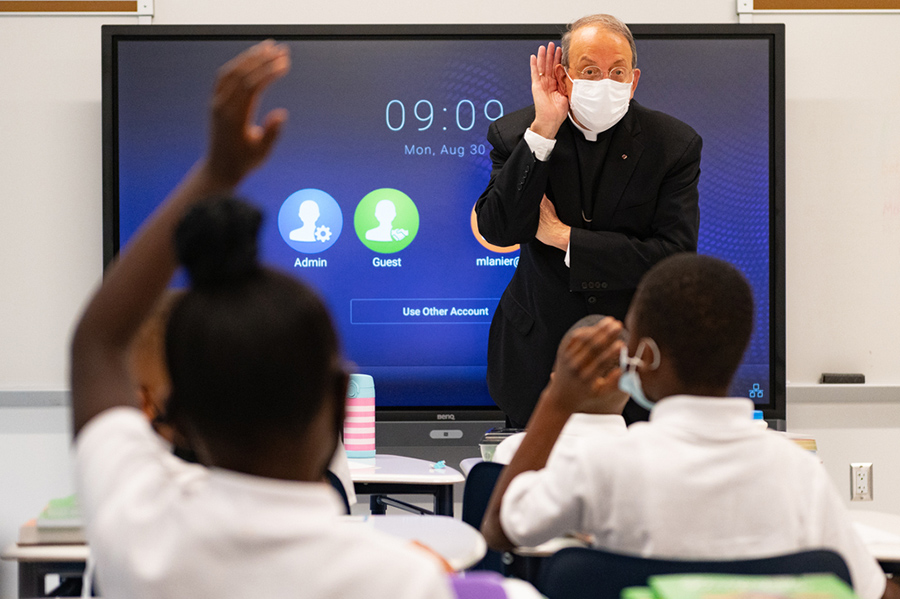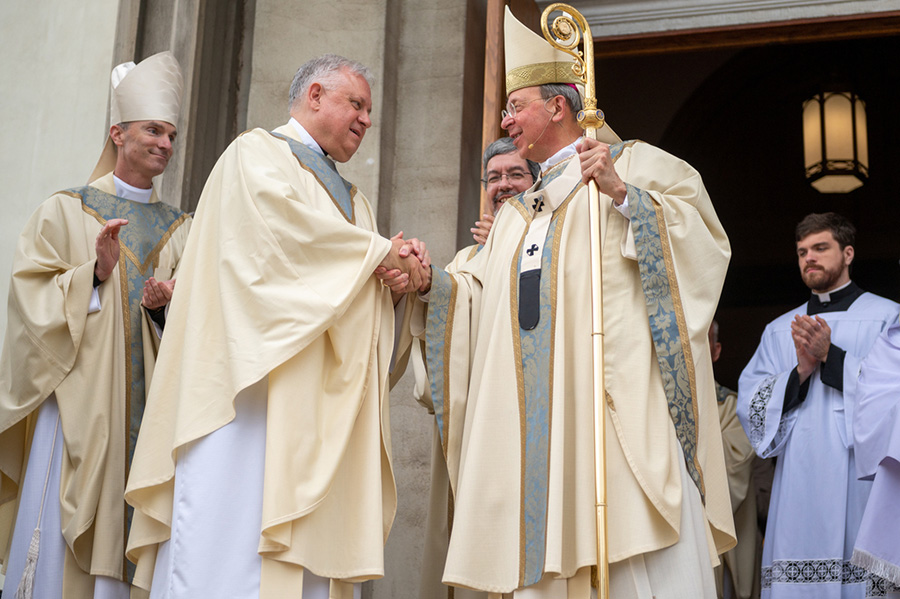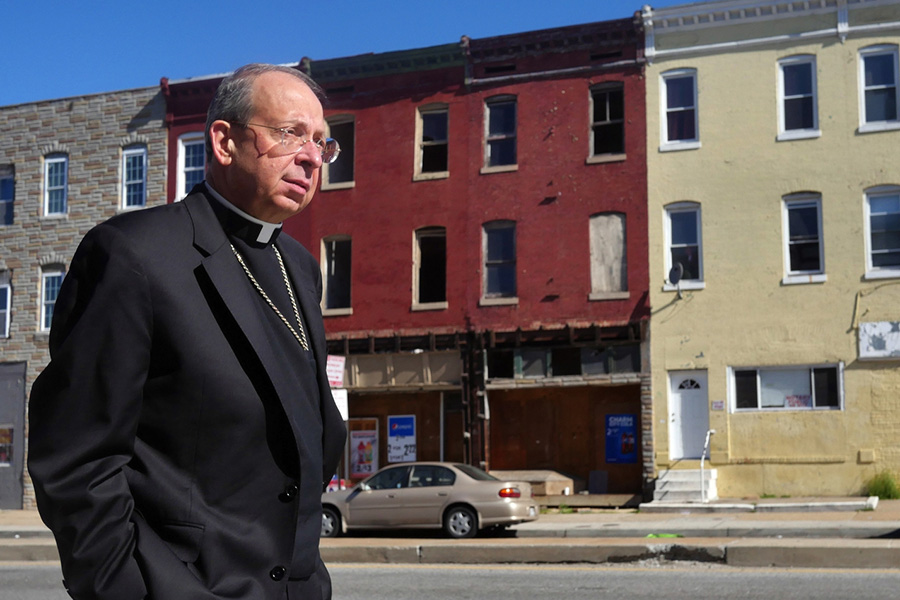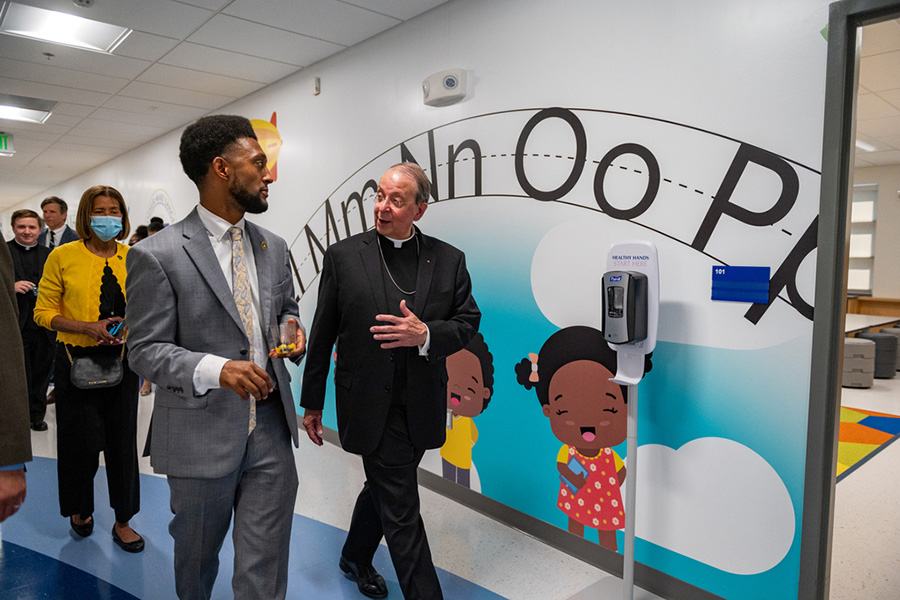Note: This is part of a package of editorial content celebrating the 10th anniversary of Archbishop William. E. Lori’s installation as archbishop of Baltimore and the 45th anniversary of his priestly ordination. Read all the stories here.
Archbishop William E. Lori sat down with Catholic Review Media for a wide-ranging interview in advance of his 10th anniversary as 16th archbishop of Baltimore and 45th anniversary as a priest.
The archbishop’s tenure since his installation May 16, 2012, at the Cathedral of Mary Our Queen has been marked by changes in demographics of the archdiocese and a renewed focus on parish planning in the context of evangelization.
He guided the faithful through continued crises surrounding clergy sexual abuse – including revelations about Theodore McCarrick, former archbishop of Washington, and the release of a Pennsylvania Grand Jury report that detailed decades of abuse by clergy.
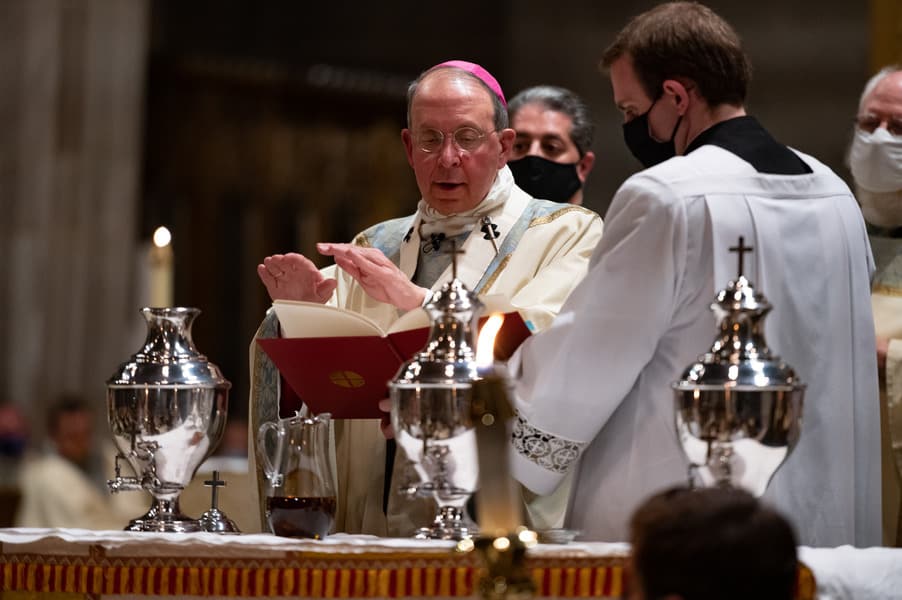
He addressed issues of violence and racial injustice, especially after riots in 2015 after the death of Freddie Gray Jr. in police custody. Near the one-year anniversary of that unrest, he led an interfaith group to Rome to meet with Pope Francis and to pray for peace in the city.
Clear in the conversation is how much Archbishop Lori loves the flock that he shepherds, the people in the archdiocese. When he visits parishes or schools, he often is one of the last to leave, as he greets every person who wishes to see him. His face shines more brightly as he takes time to talk with young and old, clergy and lay.
As the archbishop prepares to mark 10 years in Baltimore, he talked about evangelization, vocations, relations with civic leaders, and some of his favorite places to pray in the archdiocese.
Portions of this interview pertinent to specific topics have been included in other stories in this section. Some answers have been edited for length or clarity.
Q: Let’s start by talking about evangelization. Your pastoral letters – “A Light Brightly Visible,” which was 2015, and “A Light Brightly Visible 2.0,” which was in 2021 – focused on evangelization and helping parishes become centers for making missionary disciples. Why is this such a critical aspect for our church in this time?
Lori: Evangelization is the mission the Lord gave us before he ascended into heaven. He said, “Go and preach the Gospel and baptize,” and that is a perennially valid mission.
It takes different forms at different times in the church’s history, but today, it’s very, very important because in the society in which we live, people really need to hear the Gospel, they really need to know the person of Jesus Christ. They need to fall in love. They need to bring the beauty, the joy and the truth of the Gospel to bear on our very secular culture.
Our church has also lost ground as some people have left the church without really knowing the Lord, without really knowing their faith, without really seeing its beauty. It’s up to us to make contact, to invite them back.
Evangelization, as Pope Paul VI said, is not just a program. It’s not just an activity of the church; it’s the church’s deepest identity.
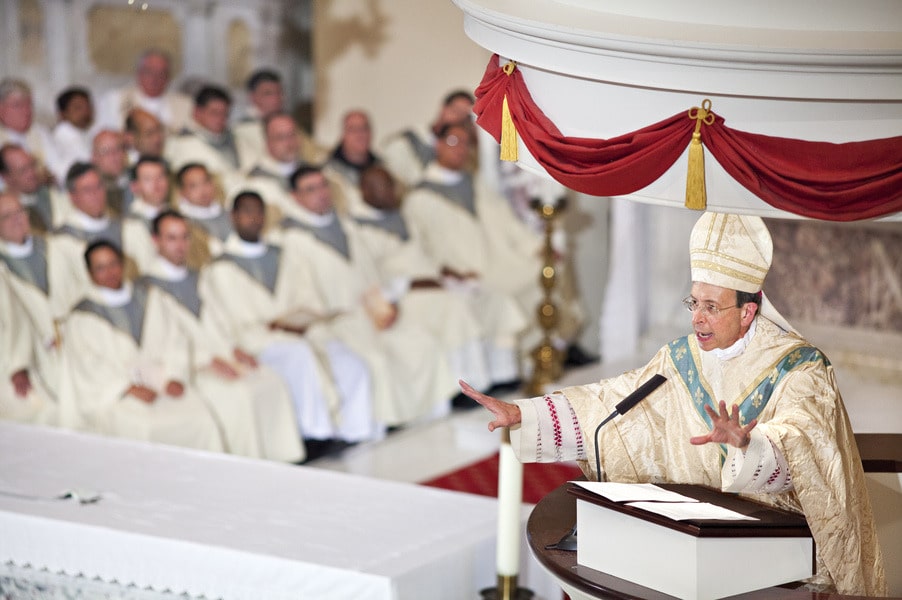
Q: You recently revamped your focus on evangelization to establish the Institute for Evangelization at the archdiocese with parish renewal teams. What does that change mean?
Lori: The approach that we are taking is dynamic. At the heart of the of the effort are the Emmaus Teams, and these are well-qualified missionary disciples who go out as teams and engage parishes to help foster their mission of evangelization. They work with pastors, they work with parish staffs, pastoral councils, finance councils, parishioners at large, recognizing that evangelization is not a program, but it is something that is personal. This personal contact, this personal engagement, has been a key element. And they have managed to engage in a very short time more than half of our parishes in ways that are already proving to be very helpful.
Q: The Lord said I’m going to send you out two by two. That’s what you’re doing here.
Lori: We’re following the Lord’s own method, two by two.
Q: Why is it important to put parish pastoral planning within the context of evangelization?
Lori: Parish planning is not the same as corporate planning. If you’re running a business, you might say well, these branch offices are profitable. These branch offices are in a growth area and these aren’t, and we simply do this according to profit and loss.
Here, what we’re talking about is the church, the Body of Christ. We are founded on the Gospel. We exist for the Gospel. And so, as we look at demographic changes, as we look at sustainability, the question is not how do we respond to the bottom line first and foremost, but how do we bring communities together so that they can vibrantly fulfill the mission of evangelization and that’s more challenging?
That’s different, but I think that’s what we’re called to do.
Q: With the way parish planning is going, what do you see as the future for parish life in the archdiocese in the next five years?
Lori: I’m looking forward to increased vitality, increased intentionality about evangelization.
I’m looking forward to communities that are centers of mission and that are doing a lot of outreach. Now, not every parish community will survive in the way that it is currently configured. That’s going to be true, but I’m not looking for any diminishment of mission, quite the contrary.

Q: How do you envision those parishes and pastors working together in the future?
Lori: It’s happening now in many, many of our communities, we’re doing the work that brings communities together.
It’s all about relationships, isn’t it? It’s all about people working together, coming to know one another, making common cause, figuring out about what are the strengths and needs that each community brings to the other. A lot of it is just praying together and it’s a process.
It takes time, but it has happened successfully, and it is happening successfully.
Q: How do you encourage laypeople to become more involved in their faith, to become missionary disciples?
Lori: There ought to be a recognition on the part of everyone in the church that most of the people in the church are laypersons. We who are clergy, those who are religious, we’re a small percentage of the church’s life.
The church from the Vatican Council, and certainly through every pope since, has said that the laity are the chief protagonists in the new evangelization. Why? Because laypersons go where priests and religious oftentimes are not able to go. And so, what I encourage people to do is to up their life of prayer, root their life in the Eucharist, seize the many opportunities that are all around us to come to know their faith more intentionally and the opportunities that exist to learn how to do this.
But a lot of it is not a matter of being a professional, as if you’re coming to this with a degree or with credentials. The main credential is that you truly love the Lord, and you love your faith so much that you have the courage and love to share it in a convincing way.
Q: You’ve been doing a lot of listening around the archdiocese. Parishes have had a ton of listening sessions for the World Synod of Bishops that’s coming up in 2023. What are you learning from those sessions as we go around the archdiocese and how important is has that been for you?
Lori: I think there’s been some common themes that have emerged.
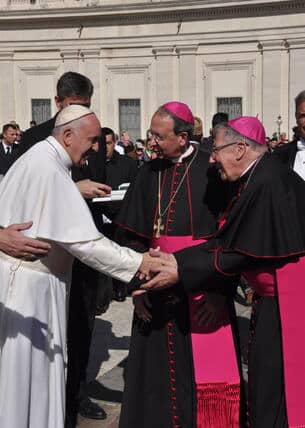
Obviously, we’ve gone through an unsettled time in the life of the church. We’ve heard about the COVID pandemic and the restrictions and the challenges that COVID has presented to our parishes and to our families.
We have certainly heard about people’s concern about having adequate pastoral leadership for the future.
We have heard concerns about racism. We’ve heard concerns about young people and welcoming young people into the faith, as we should.
I’ve heard the need for more family support. I’ve heard the need for more clarity in teaching. I’ve heard concerns about administration. So it’s been a wide variety of things.
But I think this is extremely valuable. It’s not a 30,000-foot view of the archdiocese; that’s too high up. It’s not quite treetop, but it’s just above the treetops and it enables me and my coworkers to have a kind of a good sense of what’s going on.
We think we know, but I think the synodal process is good.
The other great value is not only that we’re perhaps seeing a mosaic a little differently than we saw it before. This has been, if you will, a practice run for how to gather and to listen in the future.
So, the pope has given us training wheels so that, you know, we can learn to ride the bicycle called synodality.
Q: You mentioned the pandemic and how that has been a challenge for us as a church. Guiding the church through that has been one of those big challenges you’ve faced since you got to Baltimore 10 years ago. What were your goals and your guiding principles as you made difficult decisions to suspend Masses and then eventually bringing people back, reopen schools, reopen parishes?
Lori: The first and foremost guiding principle is pastoral love, care for the people entrusted to me, together with my fellow priests and deacons and lay leaders. And part of pastoral love is wanting to enable people to still have contact with their faith, to be able to pray, to be able to be supported in their faith, and yet, in the time of grave danger and uncertainty, to do everything possible to protect them from COVID.
Now I can’t protect everybody from COVID, but with many worship sites throughout the archdiocese and the system of schools and being a large provider of social services, it was obviously incumbent upon me to take sensible precautions.
It also was important to work with civil officials for the common good, to listen to what medical professionals were saying, and I know there were divisions and disagreements and so at some point you have to make prudential judgments. And there are those who say I was too lax, those who say that the archdiocese was too strict. But I think we tried to put the ball right down the middle of the fairway.
Sometimes people are going to disagree about things like this, but what I hope and pray is that we are emerging from the pandemic – though I think COVID will always be with us in some form, and we’re going to have to learn to live with it.
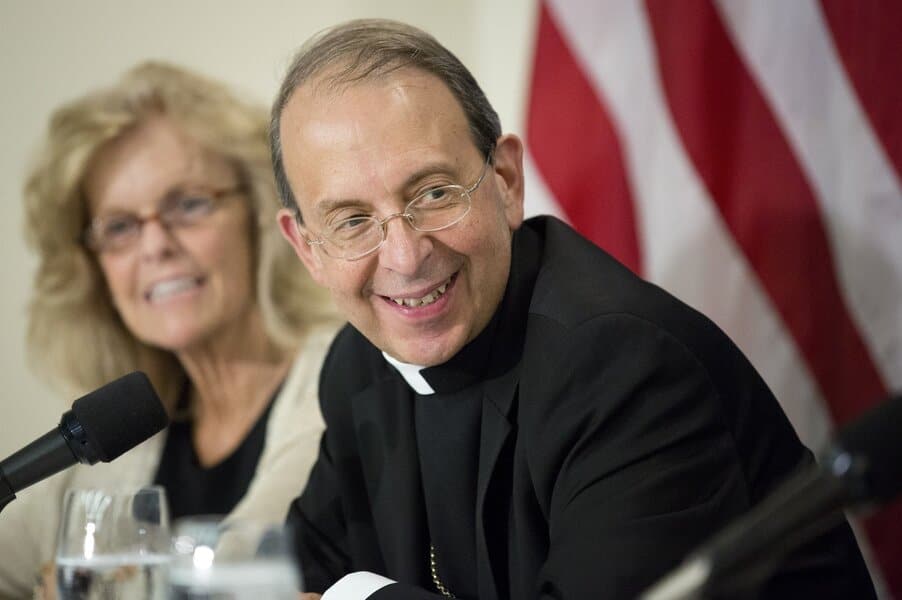
Q: Given that, how do you invite people back and get them back involved?
Lori: People are coming back to our churches. Pastors are reporting to me all around the archdiocese that the numbers are going up again. I think the parishes that did the most effective outreach during COVID are seeing the most rapid return.
I’m encouraging all parishes and all pastoral leaders, whether lay or ordained, to actively invite people back into our churches. Our churches remained safe throughout the pandemic; we closed for a time, but then we reopened with precautions, and I think our churches are still safe.
Our schools, aside from a brief period of being closed, reopened in the academic year of 2020-2021 and 2021-2022. Hats off to those principals and teachers. They did a great job and we’ve experienced this year an 8 percent increase in enrollment, and I think part of that is that our Catholic schools showed their nimbleness and their worth during the middle of this pandemic.
Q: Archbishop Lori, you’ve written two pastoral reflections on racial justice. The first commemorated the 50th anniversary of the assassination of the Rev. Dr. Martin Luther King Jr. and focused on the principles of nonviolent civil protest. The second actually acknowledged the church’s disgraceful record of having owned enslaved people and of not always being welcoming in ministry. What has been the reaction to those reflections and what progress has been made on the action steps you’ve laid out in journey to racial justice?
Lori: It’s always dangerous to comment on how well or poorly one’s own writings have been received, but generally I think the reaction has been positive.
I think that the Martin Luther King pastoral was well received, not only because it held up a great and prophetic leader in our culture – a religious and civil leader in our culture – but also because his approach, the nonviolent approach, is hugely important for the times in which we live, times that are so polarized and angry and oftentimes violent. So, Martin Luther King’s words from more than 50 years ago resonate now as much as they did when he spoke them, maybe even more.
In terms of “The Journey to Racial Justice,” I think that there was a recognition that the church was trying to not only own up to its teaching, but also own up to its past, and to learn from that past. As a result of that, a racial justice working group was formed and that group expanded and intensified its work after the issuance of that pastoral letter.
It did what all groups do: it divided up into committees, but the committees were good; they were focus areas.
And they gave me a set of recommendations which now there is a work group helping the archdiocese to implement these recommendations.
We’ve also begun a series of conversations, synodal-style conversations on racial justice all around the archdiocese.

Hats off to Bishop Denis Madden, who in many ways pioneered this work; also to Mary Ellen Russell, who helped assemble the racial justice working group.
That work has been carried forward now by Bishop Bruce Lewandowski, and I’d like to especially mention Sherita Thomas, who has really been working for us part time and on an interim basis, but she’s done more on that part-time basis than anyone I could imagine and this work is something we are committed to doing long-term.
Q: Certainly, the opening of Mother Mary Lange Catholic School on the city’s west side is a great accomplishment. How will that help the archdiocese continue to serve the people of the city?
Lori: Well, Mother Mary Lange School is a labor of love.
We recognized that we really needed to have an archdiocesan elementary school on the West Side, and we recognized that the existing facilities where our students were going were either inconvenient or not sufficiently educationally efficacious.
The thought was to put a new, beautiful school right in the heart of Baltimore, not only as an excellent school, but also as a sign of hope and a beacon of opportunity and an expression of our faith at work.
And I believe that school will serve very well for many years to come.
Q: How important is the work of Catholic Charities in serving people – Catholic and non-Catholic – within the footprint of the archdiocese?
Lori: Catholic Charities is a beautiful, beautiful work.
It’s large. We are one of the larger Catholic Charities operations in the United States. I’m very proud of its more than 80 programs. It spans throughout the archdiocese.
It’s led by an incredibly dedicated team of women and men, led by Bill McCarthy ,and I think it does wonderful, wonderful work. For example, its work with Head Start students – more than 1,000 Head Start students – case management. Everyone knows Our Daily Bread. Everybody knows the workforce development they’re doing. Catholic Charities is involved in housing and care for the elderly, behavioral health – tremendous amount of work with behavioral health and emergency services.
We say we recognize the dignity of every person at every stage of life. Catholic Charities makes that teaching Incarnate in our midst. And it’s reaching its centennial. It’s doing a large capital campaign, which is going extremely well. And I’m just very proud of what Catholic Charities is doing.
Q: How do you maintain relationships with civic leaders on the local, state and national level?
Lori: Relation-building is important. When I came, the first thing that was said to me was we’ve set up a series of meetings for you and they were for my education. So I met with the mayor, I met with members of the City Council. I met with various civic leaders throughout the city. Also private charities, people who are involved in social services agencies other than our own and kind of got to know the lay of the land that.

That really jumpstarted me to having relationships with civic officials, for example, with the mayors that have served during my time, with the police commissioners with members of the City Council, with the county executives. And the only way to do it is relationship building.
It’s getting together for breakfast. It’s of course these days it’s been meeting by Zoom.
It’s been having a good enough relationship you can pick up the phone and there’s a problem. It goes either way.
I’ve been blessed to have Mary Ellen Russell and now Yvonne Wenger to help me build and sustain those relationships. And I think it’s important to do this, and I would also say my predecessors have always done this. This is a Baltimore tradition that I’m proud to uphold.
Q: Why is it important for you to reach out to the Hispanic community, especially in Spanish? You celebrate Masses in Spanish, even if there are other priests or bishops who could do that too.
Lori: Actually, you’re being very kind in your question. Most do it better than I do. My Spanish sometimes is a bit bilingual: if you don’t understand Spanish you can understand my Spanish, but it’s important to try.
And I really appreciate the forbearance of the members of the Hispanic community as I do, because I’m not a gifted linguist.
But I also want to say how much I appreciate the rapidly growing Hispanic community and the Archdiocese of Baltimore. It’s the rapidly most rapidly growing segment of our archdiocese.
They’re here from mainly Central America from Salvador, Honduras, from Nicaragua, from Mexico. There’s a rapidly growing Latino community and a source of many, many gifts and much strength for this archdiocese.
We often talk about the newly arrived as if they were a problem. And yes, they have needs, and yes, it’s up to our parishes and the Esperanza Center run by Catholic Charities, and many other efforts too, to reach out and meet those needs.
And again, my thanks to Bishop Bruce Lewandowski for his leadership here, e.g., and to wit, but during COVID, Sacred Heart in Highlandtown was a great source of strength for providing testing and vaccination for the Latino community. But they’re not just the people who bring needs. They bring gifts, strength, faith, family, all the things that we want to see in the archdiocese.
We welcome them with open arms, and I will always say never enough.
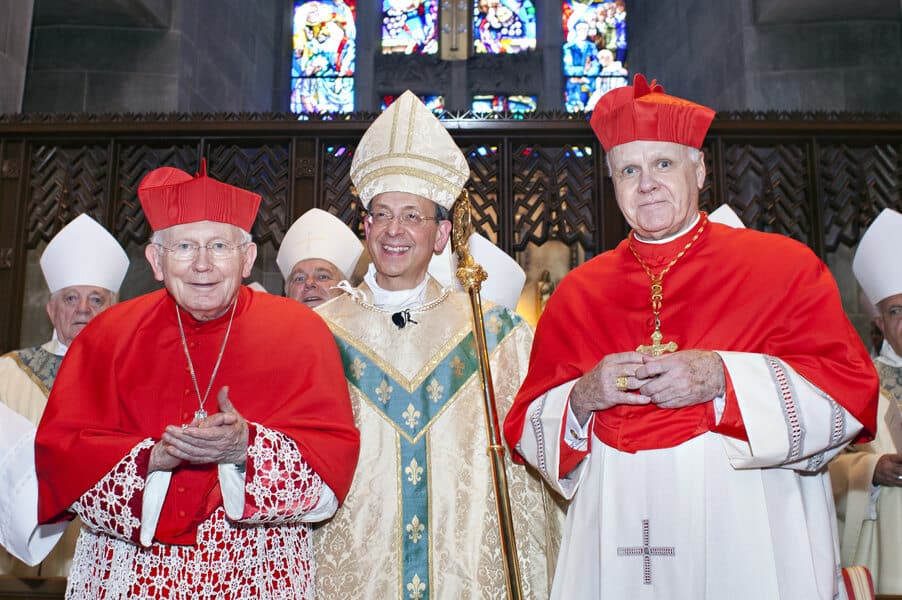
Q: Is that one of the reasons that you really are trying to make sure that all of our priests and seminarians are trained in Spanish, to be able to be bilingual and be in ministry?
Lori: I think that’s important. That’s sort of standard operating equipment for priestly ministry in 21st-century Baltimore.
Q: During your term, the Hispanic ministry launched Ministerio de la Pastoral Migratoria – ministry in multiple parishes that provides different types of help to immigrants and has and the archdiocese is also engaged in the National Encuentro. Why are these initiatives so important?
Lori: They’re on the ground. You don’t have to come to an office, you don’t have to do the big bureaucratic runaround.
It’s as close as your parish and there’s a friendly, welcoming spirit. And there’s a more of a peer-to-peer feel to it and that, as much as anything, enhances people’s dignity and makes them feel their dignity. We’re not really welcoming until we’ve affirmed the dignity of those who are coming and we can do a world of good in helping them deal with their immigration situation, whatever it might be, and any other pastoral needs that are there.
Q: As we walk with the Hispanic community, how do you encourage Anglo communities within the archdiocese to walk together and to welcome the Hispanic community?
Lori: We are living in a very diverse society and anyone who is still going to work every day, and I hope more will, but you encounter that diversity, and that diversity is a good thing. It’s a strength.
It’s always been one of the beautiful aspects of the United States, even when we’re not living up to our ideals all the time, for sure.
The church is like that too. The church is made up of every language and every race, and we say that in Scripture and now the Lord’s giving us the chance to be who we say we are. That’s the church we are.
Q: You talk about some of those other languages, and we have in the archdiocese Filipino, Vietnamese and Korean communities. How do you relate to those communities as well?
Lori: I love it. And you know, again, I’m a person with a particular background and a particular culture, but I have found nothing but wonderful, beautiful openness and all those communities.
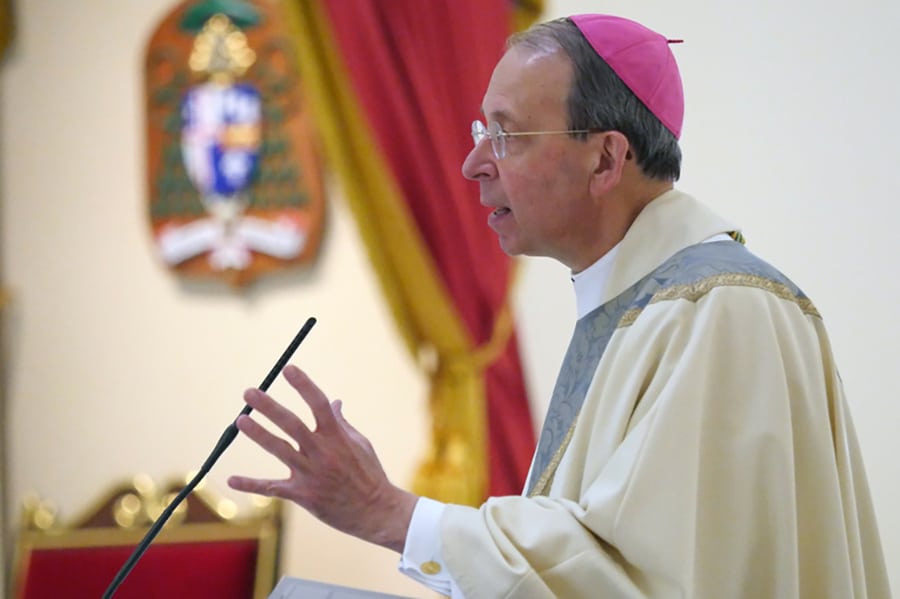
Q: How have you continued the archdiocese efforts to ensure safe environments for children?
Lori: When I came 10 years ago, I found a robust effort underway. We have built upon what was found and I do that with, first and foremost, great coworkers, and here I’d like to express my deepest gratitude to Bishop (Adam) Parker, to Jerri Burkhardt and a team of people who pay exceptionally close attention to this at every level: reviewing our history, attending to any allegation that comes to our attention, dealing openly and honestly with the police and the appropriate civil authorities, constantly reviewing our policies.
We have a very strong Independent Review Board, chaired by Dr. Jay Perman, and it is very thorough, and it meets with great regularity.
And also, by meeting with those who are the survivors of sexual abuse and being helpful and compassionate and listening attentively to their stories and their lived experience.
Q: What were your expectations when you learned the Holy Father had picked you to be the next Archbishop of Baltimore, and ten years in, how are those expectations working out?
Lori: Well, there were rumors all over the place and I always like to say that in this case, the papal secret regarding the appointments of bishops was really poorly kept. I mean, there were rumors all over the place. Not even I could miss them. So, I was not entirely surprised.
The minute I was asked, I really think the Holy Spirit does hover over us, and the minute I was asked, I said to myself, I don’t know Baltimore. I might have been in Washington for 24 years, but Baltimore is not Washington, and Washington is not Baltimore. And Fairfield County (Connecticut, where the Diocese of Bridgeport is based) is not either Washington or Baltimore. And so, I said, I have a learning curve.
So, what I tried to do is to come to Baltimore without too many preconceived notions. Now, I had been to Baltimore many times. I knew Cardinal (William H.) Keeler well. I knew Archbishop (Edwin F.) O’Brien – now Cardinal O’Brien – very, very well. I knew priests of Baltimore.
So, I had some experience and there was always interaction between the two archdioceses (of Washington and Baltimore). But I said none of those things really give me a good window into Baltimore.
So, I wrote to all the priests and said tell me what do you see? And, boy, I think everybody wrote me to a person. I still have those letters, and one of my jobs in this 10th year, as it was in my fifth year is to pull them out and read them again.
So, I learned gradually the archdiocese and I’m really in the deep end of the pool now.
Q: You got out and around and you’ve gone to all the parishes you’ve done all that so.
Lori: I did that. I’ve listened. I’ve had sessions with priests and I had sessions around the archdiocese and they were very helpful and I must say that I’ve been humbled all 10 years by the kindness and receptivity with which I’ve been welcomed.
Q: Now you’ve been a priest for 45 years. What are some of the most significant moments of that time?
Lori: Well, you could answer that in many different ways.
I mean, you could answer it (by saying) being asked to do things you never thought you would be asked to do.
Early on, I was supposed to be a seminary professor at Mount St. Mary Seminary. I was supposed to teach sacramental theology. I got my doctorate, bought my books, had my lesson plans ready and kaboom, I was Cardinal (James A.) Hickey’s (archbishop of Washington) secretary, and we were going to try it for six months. And it turned into 18 years of direct service for him – different capacities but direct service.
Becoming auxiliary bishop was probably a really big surprise to me, because I assumed that there were some much more senior priests in the archdiocese and that I figured one of them would become the auxiliary bishop. That was kind of a surprise.
But the biggest and most significant moments are none of those things – none of the appointments, none of the responsibilities.
Really, the most significant moments have been in the confessional, when people have bared their soul to me, not as William E. Lori, but as a priest. When I have been at people’s deathbeds, when people have come and shared their stories with me, when couples have come and they’ve had challenges.
Those remain the most significant things to me, that’s why I always felt God called me to be a priest in the first place. And thankfully, those moments still happen. I consider it to be the deep beauty of the priesthood.
It’s not about power. It is not about power. It is about these moments when it’s not you, it’s the Lord working through you, that is able to listen and offer a healing touch. It’s what gets me up in the morning.
Q: We’re about to finish up the Year the Eucharist that you’ve established to try to get people on fire for the Real Presence. The U.S. bishops are launching a three-year project, the Eucharist Revival Project. Why is the Eucharist so important to what we have been doing?
Lori: If you look at the structure of the Gospel of Matthew – Matthew is on my mind today – Jesus preaches the Gospel, then he works his miracles and then he suffers his Passion and death for our redemption. That’s what the Mass is. Jesus speaks to us in the Scriptures. Then he touches our hearts and opens them up, works miracles of grace and then we participate in what he did to save us – his saving death and Resurrection – and last of all, he comes to abide in us.
That’s the goal of evangelization: communion with the Lord of life and of love. That’s my passion.
The Year of the Eucharist has been like the preparatory year for the Eucharistic Revival. I really want to take this occasion to invite Catholics from all around the archdiocese to converge on the Cathedral of Mary our Queen on the Feast of Corpus Christi (June 19), where we will close the year of the Eucharist and open the eucharistic revival.
I’d love to see that cathedral overflowing with people and will have a beautiful eucharistic procession that day.
Q: You put your support behind a mental health initiative that’s going to train 1,000 people in our parishes and schools to identify children and adults who might be in crisis and then provide mental health first aid, connecting them to resource resources. Why did you see the need to do this?
Lori: I heard from pastors, from educators and from others that in the middle of COVID, people were experiencing mental health challenges and in some cases COVID revealed pre-existing mental health challenges. And one of the jobs of pastoral ministry is to connect people’s needs and services on the way to wholeness, on the way to holiness.
And so, we said one of the things we can do is train volunteers to not only recognize the signs of it in the people we interact with, but also to connect them with resources.
And we’re well on our way to training these volunteers. I’d invite anyone who would like to join this to do so.
Q: You’re talking about connecting people to resources. Another project that you’re that is near and dear to your heart is the Walking with Moms in Need. You’re the new chairman of the U.S. bishops’ Committee on Pro-Life activities and Walking with Moms in Need is a way for parishes to help people in pregnancies connect to the resources they need. Why is that so important?
Lori: It’s important for a variety of reasons. First of all, I think we owe it to women facing difficult pregnancies not just to say abortion is wrong, but to say we love you, we will walk with you. We will help you. We will care for you. We will care for you while you are pregnant. We will care for you while you’re bringing your baby to term. We will care for you when you have young children and you maybe don’t have the resources that you need.
That’s the church is teaching on life in its fullness. And when people see that the church’s teaching on life is not harsh or judgmental, but compassionate and accompanying – to use the pope’s word – not only Catholics, but many people of goodwill say, you know, that teaching is really beautiful.
And that’s what we ought to be like. And in fact, that’s what our culture ought to be like. That’s what you call the pro-life movement.
Q: Pro-life is also very important to you personally. Why?
Lori: For a lot of reasons, but I think it’s important for me because of pastoral experience. I mentioned this at the opening Mass – the vigil Mass of the March for Life.
Many a time as a young priest and all through my priesthood, I have sat with couples and women contemplating an abortion. And thank God, I mean, often you don’t get that privilege to do that. And I’ve seen the anguish. You get some sense – I can’t pretend to understand – but you get a sense of that, and your heart aches and you want to help. And you recognize that the pro-life movement is not about condemning. It’s about compassion and help, and about truth-telling in the larger society and truth-telling about the humanity of the unborn child.
It’s a movement, it’s multifaceted, but it is beautiful and compassionate.
Q: The numbers show that we’re going to have a number of priests retiring in the coming years, but we also have a good number of men in the seminary system at this point, and we have five men to be ordained this year as priests and nine to be ordained as transitional deacons. That’s a pretty good showing at this point. What have you been doing to bring men into the seminarian and discern a priestly vocation?
Lori: I have a huge passion for priestly vocations, and I’m most grateful to the Lord for sending us these fine young candidates for the priesthood.
I think the one thing is to have good coworkers. I depend on my coworkers. Father Steven Roth, and now Father Matthew Himes are not only dedicated to this, they’re very wise and discerning and how they go about it.
I’m grateful to my brother priests who encourage vocations in their parishes, grateful to families who are generous in supporting vocations.
One of the things I try to do is to really know my seminarians, sit down with them a couple times a year, try to walk with them and they’re in their formation.
I think the Lord said he’d give us pastors, but he also wants us to pray. He also wants us to encourage. He also wants us to walk with those who have answered the call.
Q: How do you encourage vocations to aspects of religious life other than the priesthood?
Lori: You know, it’s a beautiful thing to be called to the consecrated life. Consecrated life means in a particular way, making a total gift of yourself.
I do meet young people contemplating that. From the basilica here, we’ve had several religious vocations and there’s religious vocations I find out, sometimes after the fact, all over the archdiocese. Not the numbers we used to have, but it’s still happening and whenever I meet someone who’s making a discerning a call or religious life, I think I would encourage them to do so.
Q: As Supreme Chaplain of the Knights of Columbus, you have a chance to speak often to Catholic men. You write a column every month for Columbia magazine, but how do you inspire Catholic men these days to live out their faith?
Lori: We just finished the Baltimore Men’s Conference Men’s Fellowship Conference.
I do have occasion to meet and speak often to my brother knights. I think that first it begins with recognizing that sometimes men find themselves in conflicted situations.
They are men of faith. They’re most often husbands and fathers. But they’re being pulled by a culture that is very often destructive of family life and sends very confusing signals about what it means to be a man or a woman, to be a husband or a father or a mom.
And I think it is important to help men to be men, to be good men, to be virtuous men, to be grateful to be the person God meant them to be, and to embrace their faith – to embrace their faith, not only as lone rangers, but with some fraternity, we all need fraternity. We also need an outlet for our faith, that’s charity.
We all also need to have a sense that we’re part of something bigger; that’s unity. The Knights of Columbus for some time now has really positioned itself to become the premier men’s group. That’s not to say the other men’s group aren’t great and necessary, they are. But then I’m the Supreme Chaplain, I have to put in a really strong word of encouragement for any Catholic man listening to this who’s not already a knight to become one.
Q: You always try to greet everybody after Mass. I’ve seen you standing for hours, really, doing that. Why do you do that and how have these encounters affected your ministry?
Lori: I just love it. I just love meeting people. I love the opportunity to talk to them.
That’s some of those significant moments – people take me aside and it might be a five-minute conversation, but you’d be surprised. You’d be surprised.
The people of God is not a concept. The people of God are people. And, I think that the pope says sometimes you’re in front, sometimes you’re in back, sometimes you’re in the midst. I’m actually most comfortable being in the midst, and I like it.
I’m not a populist, you know, I’m not a politician. I don’t remember everybody’s face and name like some folks do, but I like being with people. And I love our Catholic community here.
Q: And in closing, what’s the best thing about being Archbishop of Baltimore?
Lori: Best thing about being Archbishop of Baltimore is Baltimore and the nine counties that go with it. Baltimore is a uniquely important place, but I think the best thing for me is that this has become my home. And it’s, God willing, my home for a long time to come.
Now for some fun stuff.
Q: How’s your mom doing? How old is she now?
Lori: Mom is 102. Someone said to me, well, your dad lived to be almost 99. Your mom’s 102. You’re going to be around a while.
I always say, well, Mom and Dad lived sensibly, and the jury is certainly out (on me).
Mom is amazing. She is confined to a nursing home. Her mobility is limited, but her mind and heart are not. I call her every single day, except once in a while when travel might get in the way, but we chat. And Mom is tracking and she’s still mom.
Q: I understand you like to doodle. Have you been doing that for a long time?
Lori: I since I was in elementary school and sometimes I got in trouble doing that because some of the doodles look suspiciously like my seventh-grade teacher who was a nun, and yeah, I doodle.
Q: Does it help you relax?
Lori: Yeah, and my mom actually was endowed with great artistic ability. She could paint, so whatever semblance my doodles have to actual living persons, I got that from my mom.
Q: Do you prefer coffee or tea?
Lori: Coffee
Q: Who’s your favorite saint?
Lori: Blessed Virgin Mary, followed by St. Joseph, followed by soon to be St. Blessed Michael McGivney, we hope and pray.
Q: Why have you always had golden retrievers?
Lori: Love that face.
Q: What’s your favorite route to walk Bayley?
Lori: Bolton Hill
Q: How many books do you own?
Lori: Too many.
Q: What are your favorite genres to read and what are you reading now?
Lori: I love to read biography. I’m reading a huge biography on Winston Churchill.
Q: Who’s your favorite U.S. president?
Lori: Well, I’m going to get in trouble on this one. This is not a political statement; it is a statement of historic interest. It’s Franklin Delano Roosevelt.
Q: Why is that?
Lori: He’s a study in leadership. He’s a fascinating personality and the period of time in which he was president – the Great Depression, World War II – a person who was a patrician yet connected with ordinary people, there’s a lot to learn there. There’s a lot not to learn, but there’s a lot to learn.
Q: What are some of your favorite places to pray in the archdiocese?
Lori: Many. One is the basilica. There’s my little chapel upstairs, which is where I pray most often. The Cathedral of Mary our Queen, which I’ve come to love and appreciate deeply.
I love Our Lady of the Angels – absolutely, absolutely lovely. I love St. Ann’s in Grantsville. I’ve been there a couple of times. Monsignor (Jim) Hannan built that church with his people, and you look out over the mountains. That’s one of my favorite places to pray, but there’s a lot of others.
Q: What are some of your favorite places to eat in the archdiocese?
Lori: At home. I really like to be home. If I can have a night at home and it’s just me and the household and the dog. It’s my favorite place and situation in which to eat.
Q: How often do you get to exercise and is that important for your health?
Lori: I try every day, and yes, it is important for my health.
Q: What’s your favorite movie?
Lori: I don’t know (that) I’ve ever thought about having a favorite movie. I like old movies. One of the great disappointments of my life is when the cable service, on its own, unauthorized Turner Classic Movies; I’ve been offering that up ever since. I don’t watch a lot of stuff, but everyone says what I do watch is mostly in black and white.
Q: What is the weirdest or most interesting food you’ve ever tried?
Lori: I haven’t been very adventuresome. I’ve been overseas a lot, but nothing I’ve been served has seemed all that adventuresome to me, to be honest with you.
I’m a little monochromatic.
Q: What’s your favorite spot to take a day trip in Maryland?
Lori: I’ve been up around Harpers Ferry, around Antietam. I find that neck of the woods to be really very interesting, and it’s within the archdiocese, but it still feels like you’re at home and yet you’re away.
I love the Civil War history; it’s pretty interesting. And if I can be out in that neck of the woods, it’s very relaxing.
Q: Besides reading and spending time with Bayley, what’s your favorite way to relax?
Lori: Frankly, exercising, I think, when I try to do 45 minutes to an hour a day on the elliptical. Otherwise, I take a four- to five-mile walk and that really helps. On the elliptical – some people can read and some people can do meditation or say the rosary. I’m busy staying on the machine.
But when I walk, though I can clear my mind, think some things through, say a rosary, say a chaplet of Divine Mercy and that’s very relaxing to me.
Email Christopher Gunty at editor@CatholicReview.org
Read More Archbishop Lori Milestones
Copyright © 2022 Catholic Review Media
